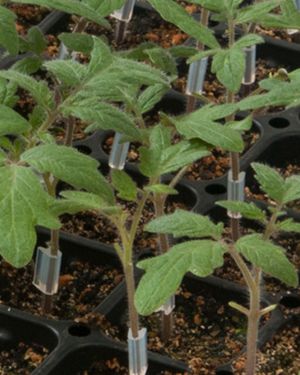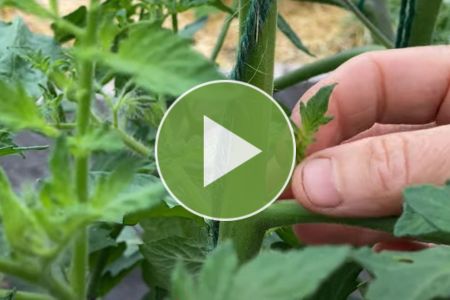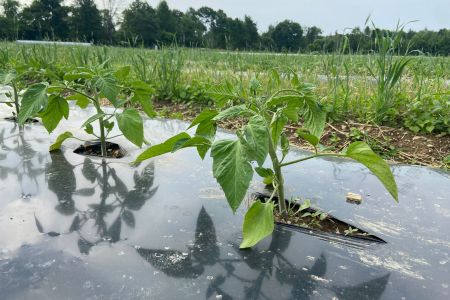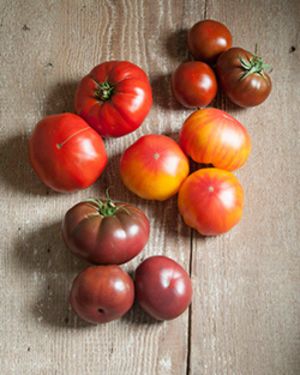- Video: 'Cherry Bomb' | JSS-Bred Organic Cherry x Grape Tomato from Johnny's
- Open-Pollinated Revival Project: 3 Improved OP Heirloom & Heritage Tomatoes
- 3 Ways to Choose the Best Tomato Varieties | Johnny's Selected Seeds
- Video: Tomato Pruning 101 • Tutorial with Niki Jabbour
- Tomatoes: 10 Unsung Heroes | Johnny's Educational Webinar Resources
- Video: Tomatoes: 10 Unsung Heroes | Johnny's Webinar Series
- Video: High-Value Crops & Varieties for Your Garden • Tutorial with Niki Jabbour
- 10 Tips for Growing Heirloom Tomatoes
- Fundamentals of Tomato Grafting | Johnny's Educational Webinar Resources
- Video: How to Prune Greenhouse Tomatoes
- Video: How to Graft Greenhouse Tomatoes
- Video: Artisan Tomatoes™ | from Johnny's Selected Seeds
- Greenhouse Tomato Varieties | Comparison Chart (PDF)
- Video: How to Identify Late Blight on Tomatoes
- 'Honey Bee' and 'Queen Bee' Organic Cherry Tomatoes With Late Blight Resistance From Johnny's
- Tomato Innovation: Breeding & Trialing for Your Finest Harvest
- Video: Tomato Variety Trends: How Breeding Influences Your Seed Selection | Johnny's Webinar Series
- Top-Grafting Tomatoes | Advantages, Materials, Technique | Tech Sheet (PDF)
- 'Honey Bee' and 'Queen Bee' Organic Cherry Tomatoes With Late Blight Resistance From Johnny's
- Determinate Tomato Varieties | Comparison Chart (PDF)
- 'GinFiz' & 'Margold' Beefsteak Tomatoes for the Greenhouse
- Grafted Tomato Plants | Key Growing Information
- 'Maxifort' Rootstock Tomato Germination | Tech Sheet (PDF)
- Video: 'Clementine' | The Tangerine-Colored, Organic Cocktail Tomato from Johnny's Breeding Team
- Video: Growing Tomatoes in Containers with Niki Jabbour & Johnny's
- French Heritage Tomato Varieties | The Best of the Old World Marries the New
- Webinar Slide Deck | Fundamentals of Tomato Grafting | 15-pp PDF
- Grow a Rainbow Mix of Cherry Tomatoes
- Video: 'Mochi' : The Gumdrop-like Cherry Tomato | Exclusively from Johnny's
- Video: Choosing & Growing Paste Tomatoes for Sauce-Making • with Niki Jabbour
- Trellising & Crop Support Systems for Tomatoes | Stake & Basketweave, Stake & Hanging String/Wire, Lower & Lean
- Tomato Production Challenges & Issues | Tech Sheet (PDF)
- Greenhouse Tomatoes | Key Growing Information
- Video: How to Prune Tomatoes
- Greenhouse Tomato Pruning & String Trellising | Tech Sheet (PDF)
- Heirloom Tomato Varieties | Comparison Chart (PDF)
- Late-Summer Recipe Preview with Farmer-Chef Frank Giglio | Three Lily Farm, Thorndike, Maine
- Video: How to Grow Cherry Tomatoes • From Seed to Harvest
- Paste, Plum & Roma Tomato Varieties | Comparison Chart (PDF)
- Webinar Slide Deck | Tomato Variety Trends: How Breeding Influences Your Seed Selection | 29-pp PDF
- Video: An Intro to the Fundamentals of Tomato Grafting Success | Johnny's Webinar Series
- Side-Grafting Tomatoes | Advantages, Materials, Technique | Tech Sheet (PDF)
- Common Tomato Pests, Diseases & Physiological Disorders | An Overview of Biotic & Abiotic Problems
- Video: How We Process Our 'Washington Cherry' Tomato Seed
- Webinar Slide Deck | Tomatoes: 10 Unsung Heroes | 34-pp PDF
- Tomato Variety Trends: How Breeding Influences Your Seed Selection | Johnny's Educational Webinar Resources
- Rootstock Tomatoes | Key Growing Information
- Video: How to Manage Late Blight on Tomatoes (Phytophthora infestans)
- Video: 'Hot Streak' : The Vibrant New Striped Tomato | Exclusively from Johnny's
- Tomatoes | Key Growing Information
- Top-10 Field Tomatoes to Try in Your High Tunnel
- Video: Tomato Top-Grafting Demo: Splice Grafting & Cleft Grafting • Materials & Technique
- Tomato Innovation: Breeding & Trialing for Your Finest Harvest
- Basket-weave Trellising Instructions for Tomato & Pepper Plants | Tech Sheet (PDF)
10 Tips for Growing Heirloom Tomatoes
Recommendations from Johnny's Research Team
Heirloom tomatoes are a favorite crop of many growers, bringing both a premium price and customers in search of old-fashioned tomato flavor. Growing heirloom tomatoes can be tricky, though; they often require more labor and produce lower yields than modern tomato varieties.
The biggest concern with heirloom tomato production is disease. Unlike modern hybrids, which have generally had disease resistance bred into them, most old-fashioned varieties have minimal resistance. As a result, heirlooms may not produce for as long a time period as disease-resistant varieties. And if they lose a significant amount of foliage to disease, they won't taste as good as they should because it's the leaves that convert sunlight into sugars and other flavor compounds. Preventing disease, then, is paramount for commercial production of heirloom tomatoes.
In this article, we recommend 10 strategies that can help make heirloom tomatoes profitable for your farm.
1 • Learn to Graft
The single most effective cultural practice with heirloom tomatoes is to use grafted plants, with the heirloom variety grafted onto a vigorous, disease-resistant rootstock.
Grafted heirlooms can produce yields 30–50% greater than nongrafted heirlooms. Grafting reduces the risk of soilborne diseases, and many growers feel that it leads to an overall vigor that helps the plants resist foliar diseases as well.
Learn more about grafting:
- Fundamentals of Tomato Grafting • Webinar Replay
- Guide to Side-Grafting Tomatoes • Tech Sheet (PDF)
- Guide to Top-Grafting Tomatoes • Tech Sheet (PDF)
- Tomato Top-Grafting Demo: Splice Grafting & Cleft Grafting • Video
- View all our Tomato Rootstock
2 • Protect & Support
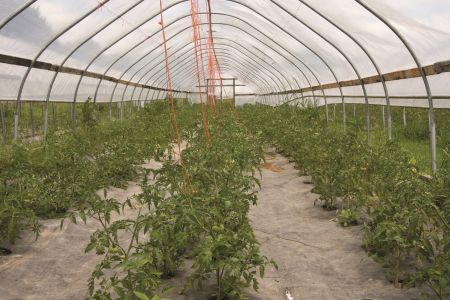
Many tomato diseases thrive in moist conditions; you can reduce risk of disease by growing heirloom tomatoes under cover where their foliage stays dry.
Heirloom tomatoes do better when grown in high tunnels, where their foliage stays dry. Many tomato diseases thrive in moist conditions, including late blight, leaf mold, Botrytis and Alternaria.
Because most heirlooms form big, vigorous plants, they require a tall tunnel and a strong trellising system. Greenhouse and high-tunnel tomatoes are typically pruned to a single leader that is trained to a string that can be lowered later in the season, so that fruits remain accessible from the ground. Grafted heirlooms can, however, be trained to a double leader, so fewer plants are required (making grafting more cost-effective). To accomplish this, all suckers need to be pruned except the one directly below the first flower cluster. That sucker will grow into a second main stem. Labor-saving innovations such as the Rollerhook® and Tomahook simplify the lower-and-lean process.
Learn more about trellising tomatoes:
- Trellising & Crop Support Systems for Tomatoes • Article
- Lower & Lean Tutorial • Video
- Basket-weave Trellising Instructions • Tech Sheet (PDF)
- Greenhouse Tomato Pruning & Trellising • Tech Sheet (PDF)
- View all our Crop Supports & Trellising Supplies
3 • Prune Correctly
Because most heirloom tomatoes are vigorous growers, they do need to be pruned more often. Pruning (also called "suckering") is important because removing suckers provides better air circulation, which helps prevent foliar diseases. Pruning also encourages larger fruit production at the top of the plant.
Video tutorials on tomato pruning:
4 • Space Generously
Planting tomatoes with wider spacing is another strategy to increase air circulation and thus reduce disease pressure. Our standard spacing recommendation for indeterminate tomatoes is 24–36" between plants and 4–6' feet between rows. With heirlooms, wider spacing in either or both directions will improve air flow.
5 • Grow on Mulch
In the field, tomatoes should be grown on mulch to prevent soil splash as well as to warm soil, conserve soil moisture, and prevent weeds, all of which benefit marketable yields.
Black Solar Mulch, SRM Red Mulch, and Bio360 Biodegradable Mulch are options recommended for tomato production.
6 • Lay Drip Lines
To keep foliage dry, drip irrigation is preferable to overhead watering.
Additionally, fertigation (fertilizing while irrigating) through the drip line is preferable to foliar feeding.
7 • Prevent Disease
A disease prevention program is essential in areas where tomato disease pressure is high. Begin by applying RootShield ® to transplants before setting them out. The active ingredient is a beneficial fungus that grows onto plant roots and provides protection against root diseases. Once planted, tomatoes should be inspected regularly for any sign of disease—easy to do with heirlooms because you'll be pruning them often.
Learn more about common tomato diseases:
8 • Choose Varieties with Care
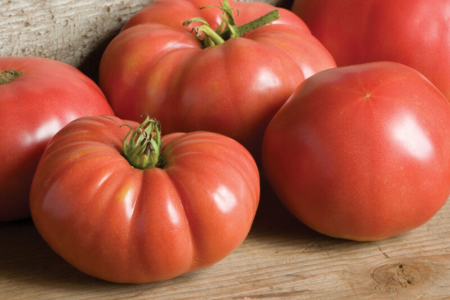
We recommend 'German Johnson' as a "easy choice." It is easier to grow than other heirlooms, with vigorous growth, high yields, and a deep, acidic tomato flavor.
Take a methodical approach to choosing heirloom varieties to grow. Trial a range of varieties and keep records, to pinpoint those that perform best in your conditions. As a quick reference on color, days-to-maturity, size, and texture, use our Heirloom Tomato Variety Comparison Chart.
Learn more:
- 3 Ways to Choose the Best Tomatoes• (Article)
9 • Water Judiciously
Most heirloom varieties have thin skin, which enhances eating quality but also makes the fruit prone to splitting on the vine. Being careful not to overwater can help to reduce the number of splits. Plus, when tomatoes receive more water than needed, the excess is directed into the fruits, which has the effect of diluting flavor.
By providing whatever water is required intermittently, in several smaller irrigations rather than continually, you can alleviate fruit splitting and gain better flavor. Some growers dry-farm their tomatoes; whether you experiment with this practice in the name of science or necessity, it boils down to fairly heavy initial watering to establish deep roots then ceasing irrigation after the first fruits set.
Whatever your approach to watering, if you carry a portable moisture meter you can obtain quick, accurate soil-moisture readings. Keep notes to perfect when and how much.
10 • Consider Heirloom-like Tomato Varieties
Newer, heirloom-like varieties have been classically bred to produce fruit that have all the exquisite flavor and eating quality of true heirlooms, but from plants that have better overall vigor and disease resistance than heirlooms. The favorable yield and flavor from these newer "tomato hybrids from heirloom genetics" goes a long way toward justifying their slightly higher cost per seed: they simply produce a lot more without being prone to keeling over from disease the way heirlooms sometimes do.
Here are 3 "hy-loom" (F1) options you may consider trying:
- 'Marnero' is very similar to 'Cherokee Purple', long regarded as one of the best tasting heirlooms.
- 'Margold' resembles 'Striped German', an heirloom revered for both its sweetness and its beautiful appearance.
- Third, there are many imitations of the classic French heirloom 'Marmande' on the market today, but our trials have shown us that 'Marbonne' offers, by far, the best flavor of the bunch, along with excellent vigor and disease resistance for field production or protected culture.
These heirloom-like hybrids faithfully (and remarkably) preserve the fruit quality of the heirlooms they imitate but also incorporate plant habits and disease resistances that allow for much greater yields than true heirlooms, which tend to die off prematurely in greenhouse conditions.
Grow the Best Heirlooms
To grow the best heirloom tomatoes, you will want to keep abreast of new developments, experiment a little, and refine your practices over time. Be sure to review best cultural practices for tomatoes before you start. ATTRA's free publication on Organic Tomato Production offers excellent, comprehensive advice on all facets of growing tomatoes.
With careful attention to best production practices—especially proactive disease prevention—heirloom tomatoes may become a successful, profitable crop for you, as well as a big hit with your customers.



